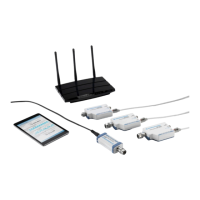Preparing for use
R&S
®
NRPxxS(N)
24User Manual 1177.5079.02 ─ 15
●
Power sensor and controlling host are connected only over the switch
(peer-to-peer network).
In both cases, you can address the LAN power sensor as follows:
●
Chapter 3.7.3.3, "Using hostnames", on page 24
●
Chapter 3.7.3.4, "Assigning the IP address", on page 26
To set up a network Ethernet connection
1. Connect the power sensor as described in Chapter 3.7.3.1, "Connecting a LAN
power sensor to the LAN", on page 21.
By default, the power sensor is configured to use dynamic TCP/IP configuration
(DHCP) and to obtain the address information automatically.
If both LAN status LEDs are illuminated in green color, the power sensor is cor-
rectly connected to the network.
Note: Establishing a connection can take up to 2 minutes per device.
2. If the LAN status LEDs show another state, no connection is possible. For possible
solutions, see:
● "Network status LED" on page 30
● "Troubleshooting for peer-to-peer connections" on page 24
Troubleshooting for peer-to-peer connections
1. Allow a waiting time, especially if the computer was used in a network before.
2. Check that only the main network adapter is active on the computer. If the com-
puter has more than one network interfaces, explicitly disable all other network
interfaces if you plan to utilize a peer-to-peer connection to the power sensor.
3. Check that the IP address assigned to the remaining main network adapter starts
with 169.254. The IANA (Internet assigned numbers authority) has reserved the
range 169.254.0.0 to 169.254.255.255 for the allocation of automatic private
IP addresses (APIPA). Addresses from this range assuredly cause no conflicts with
any routable IP address.
4. Try to establish a connection to the power sensor with both the default hostname
and the hostname extended with .local, for example:
nrp18sn-101441
nrp18sn-101441.local
3.7.3.3 Using hostnames
In a LAN that uses a domain name system (DNS) server, each connected computer or
instrument can be accessed via an unambiguous hostname instead of an IP address.
The DNS server translates the hostname to the IP address. Using the hostname is
especially useful when a DHCP server is used, as a new IP address can be assigned
each time the instrument is restarted.
Connecting to a controlling host

